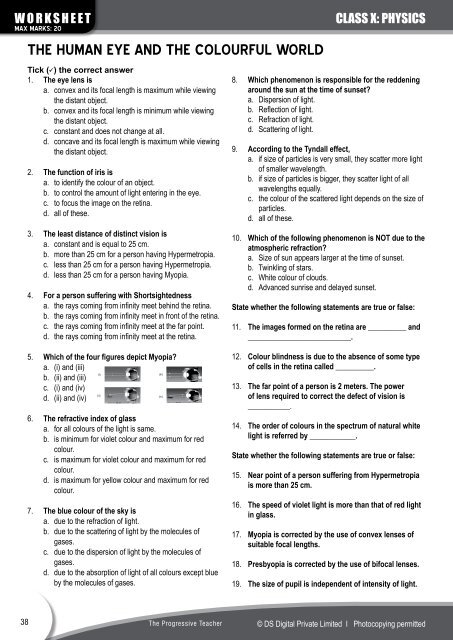revised_tpt_may_june_17 combine
Create successful ePaper yourself
Turn your PDF publications into a flip-book with our unique Google optimized e-Paper software.
worksheet<br />
Max Marks: 20<br />
The Human Eye and the Colourful World<br />
Tick ( ) the correct answer<br />
1. The eye lens is<br />
a. convex and its focal length is maximum while viewing<br />
the distant object.<br />
b. convex and its focal length is minimum while viewing<br />
the distant object.<br />
c. constant and does not change at all.<br />
d. concave and its focal length is maximum while viewing<br />
the distant object.<br />
2. The function of iris is<br />
a. to identify the colour of an object.<br />
b. to control the amount of light entering in the eye.<br />
c. to focus the image on the retina.<br />
d. all of these.<br />
3. The least distance of distinct vision is<br />
a. constant and is equal to 25 cm.<br />
b. more than 25 cm for a person having Hypermetropia.<br />
c. less than 25 cm for a person having Hypermetropia.<br />
d. less than 25 cm for a person having Myopia.<br />
4. For a person suffering with Shortsightedness<br />
a. the rays coming from infinity meet behind the retina.<br />
b. the rays coming from infinity meet in front of the retina.<br />
c. the rays coming from infinity meet at the far point.<br />
d. the rays coming from infinity meet at the retina.<br />
class x: physics<br />
8. Which phenomenon is responsible for the reddening<br />
around the sun at the time of sunset?<br />
a. Dispersion of light.<br />
b. Reflection of light.<br />
c. Refraction of light.<br />
d. Scattering of light.<br />
9. According to the Tyndall effect,<br />
a. if size of particles is very small, they scatter more light<br />
of smaller wavelength.<br />
b. if size of particles is bigger, they scatter light of all<br />
wavelengths equally.<br />
c. the colour of the scattered light depends on the size of<br />
particles.<br />
d. all of these.<br />
10. Which of the following phenomenon is NOT due to the<br />
atmospheric refraction?<br />
a. Size of sun appears larger at the time of sunset.<br />
b. Twinkling of stars.<br />
c. White colour of clouds.<br />
d. Advanced sunrise and delayed sunset.<br />
State whether the following statements are true or false:<br />
11. The images formed on the retina are __________ and<br />
___________________________.<br />
5. Which of the four figures depict Myopia?<br />
a. (i) and (iii)<br />
(I)<br />
(iii)<br />
b. (ii) and (iii)<br />
c. (i) and (iv)<br />
(ii)<br />
(iv)<br />
d. (ii) and (iv)<br />
6. The refractive index of glass<br />
a. for all colours of the light is same.<br />
b. is minimum for violet colour and maximum for red<br />
colour.<br />
c. is maximum for violet colour and maximum for red<br />
colour.<br />
d. is maximum for yellow colour and maximum for red<br />
colour.<br />
7. The blue colour of the sky is<br />
a. due to the refraction of light.<br />
b. due to the scattering of light by the molecules of<br />
gases.<br />
c. due to the dispersion of light by the molecules of<br />
gases.<br />
d. due to the absorption of light of all colours except blue<br />
by the molecules of gases.<br />
12. Colour blindness is due to the absence of some type<br />
of cells in the retina called __________.<br />
13. The far point of a person is 2 meters. The power<br />
of lens required to correct the defect of vision is<br />
___________.<br />
14. The order of colours in the spectrum of natural white<br />
light is referred by ____________.<br />
State whether the following statements are true or false:<br />
15. Near point of a person suffering from Hypermetropia<br />
is more than 25 cm.<br />
16. The speed of violet light is more than that of red light<br />
in glass.<br />
<strong>17</strong>. Myopia is corrected by the use of convex lenses of<br />
suitable focal lengths.<br />
18. Presbyopia is corrected by the use of bifocal lenses.<br />
19. The size of pupil is independent of intensity of light.<br />
38 The Progressive Teacher © DS Digital Private Limited I Photocopying permitted







